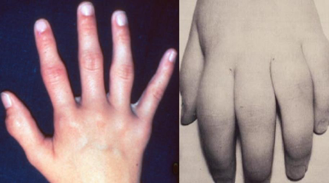Which sign is the nurse most likely to assess in a child with hypoglycaemia?
Normal sensorium and serum glucose greater than 160 mg/dL
Urine positive for ketones and serum glucose greater than 300 mg/dL
Irritability and serum glucose less than 60 mg/dL
Increased urination and serum glucose less than 120 mg/dL
The Correct Answer is C
Hypoglycaemia is characterized by low blood sugar levels. In children, symptoms of hypoglycaemia can vary, but irritability is a common sign. Other signs and symptoms of hypoglycaemia in children may include sweating, trembling, pale skin, hunger, weakness, confusion, and dizziness.
Normal sensorium and serum glucose greater than 160 mg/dL in (Option A) is incorrect because a normal sensorium (normal level of consciousness) and a serum glucose level greater than 160 mg/dL would not be indicative of hypoglycaemia.
Urine positive for ketones and serum glucose greater than 300 mg/dL in (Option B) is incorrect because it describes characteristics of hyperglycaemia (high blood sugar levels) rather than hypoglycaemia. Positive urine ketones and a serum glucose level greater than 300 mg/dL are commonly seen in diabetic ketoacidosis, a complication of high blood sugar levels in diabetes.
Increased urination and serum glucose less than 120 mg/dL in (Option D) is incorrect because it describes increased urination and a serum glucose level less than 120 mg/dL. While a serum glucose level less than 120 mg/dL could indicate hypoglycaemia, increased urination is not a typical sign of hypoglycaemia. Increased urination may be seen in conditions such as diabetes mellitus when blood sugar levels are consistently high.
Nursing Test Bank
Naxlex Comprehensive Predictor Exams
Related Questions
Correct Answer is A
Explanation
The nurse's best response to the parents of a 10-year-old child newly diagnosed with type 1
diabetes mellitus, who are concerned about the child's continued participation in soccer, is to
reassure them that it is generally safe for the child to play sports such as soccer unless the
weather is too hot.
Regular physical activity, including participation in sports, is generally encouraged for
children with type 1 diabetes as long as certain precautions are taken. It is important for the
child to have a well-managed diabetes management plan in place, which may include
monitoring blood sugar levels before, during, and after physical activity, adjusting insulin
doses as necessary, and having appropriate snacks available to maintain blood sugar levels.
Option B, suggesting the swim team as an alternative to soccer, may be a viable option if the
child or parents prefer swimming or if the child has specific concerns related to soccer.
However, it is not the best response to the parents' concern about the child's continued
participation in soccer.
Option C, recommending an extra carbohydrate snack before soccer practice, is a valid
suggestion to help maintain the child's blood sugar levels during physical activity. However,
it should be part of a comprehensive diabetes management plan and not the sole response to
the parents' concern.
Option D, encouraging intellectual activity rather than participation in sports, is not
appropriate as physical activity is generally beneficial for children with type 1 diabetes, as
long as appropriate precautions are taken.
Correct Answer is B
Explanation
Juvenile arthritis should be suspected in a child who exhibits joint swelling and pain lasting
longer than 6 weeks. Juvenile arthritis refers to a group of chronic inflammatory conditions
that affect the joints in children and adolescents. Persistent joint swelling and pain are
common symptoms of juvenile arthritis and are often accompanied by other signs such as
morning stiffness, limited range of motion, and joint warmth.
, frequent fractures in (option A) is not correct because it, is not typically associated with
juvenile arthritis. Fractures are more commonly associated with conditions affecting bone
strength, such as osteoporosis or certain genetic disorders.
lurching and abnormal gait with limited abduction in (option A) is not correct because it,
may be seen in certain musculoskeletal conditions or hip joint abnormalities, but it is not
specific to juvenile arthritis.
increased joint mobility in (option D) is incorrect because it, is not typically associated with
juvenile arthritis. In fact, joint stiffness and limited range of motion are more characteristic of
this condition.
Whether you are a student looking to ace your exams or a practicing nurse seeking to enhance your expertise , our nursing education contents will empower you with the confidence and competence to make a difference in the lives of patients and become a respected leader in the healthcare field.
Visit Naxlex, invest in your future and unlock endless possibilities with our unparalleled nursing education contents today
Report Wrong Answer on the Current Question
Do you disagree with the answer? If yes, what is your expected answer? Explain.
Kindly be descriptive with the issue you are facing.

